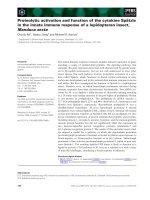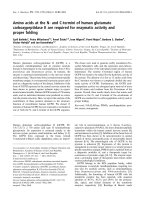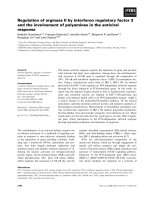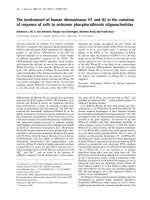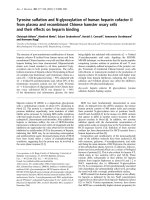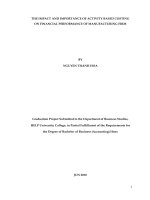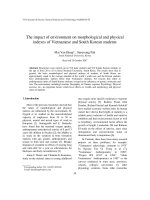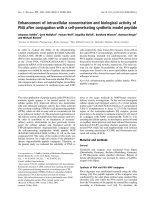Toxicological impact and histopathological response of tilapia after lead (II) nitrate (pb (n03)2) contamination
Bạn đang xem bản rút gọn của tài liệu. Xem và tải ngay bản đầy đủ của tài liệu tại đây (1.85 MB, 63 trang )
THAI NGUYEN UNIVERSITY
UNIVERSITY OF AGRICULTURE AND FORESTRY
MENDOZA, JIMLEA NADEZHDA A.
TOXICOLOGICAL IMPACT AND HISTOPATHOLOGICAL RESPONSE OF
TILAPIA AFTER LEAD (II)-NITRATE (Pb (NO3)2) CONTAMINATION
BACHELOR THESIS
Study Mode: Full-time
Major
: Environmental Science and Management
Faculty
: International Training and Development Center
Batch
: 2012-2016
Thai Nguyen, September 2016
i
DOCUMENTATION PAGE WITH ABSTRACT
Thai Nguyen University of Agriculture and Forestry
Degree Program :
Bachelor of Environmental Science and Management
Student name :
Mendoza, Jimlea Nadezhda A.
Student ID :
DTN1353110555
Thesis Title :
TOXICOLOGICAL IMPACT AND HISTOPATHOLOGICAL
RESPONSE OF TILAPIA AFTER LEAD (II)-NITRATE
(Pb(NO3)2) CONTAMINATION
Supervisor (s):
Krisna MURTI, MD., M. Biotech. Stud., Ph.D.
Duong Van Thao, Ph.D.
Abstract: To investigate the effects of environmental contaminants, histopathological
response of fish exposed to pollutants have been used as sensitive biomarkers. The
present study was conducted to assess the histopathological alterations in the gills,
heart, dorsal muscles and liver of tilapia Oreochromis niloticus which were kept in
aqueous solution of lead nitrate of two concentrations of 0.2 mg/l, 1.0 mg/l for 2 days
under laboratory conditions. The resultant histopathological changes in the gills, heart,
dorsal muscles and liver were recorded by light microscope. The observed changes in
the treated groups were disintegration of secondary lamellae, atrophy, curling and
shortening of secondary lamellae, swelling/ inflammation, desquamation, epithelial
lifting, curling bend of secondary lamellae and necrosis in gills. Atrophy and splitting
i
of muscle fibers are recognized as common changes recorded in the heart of
experimental fish. Atrophy in dorsal muscles and splitting of dorsal muscle fibers,
necrotic damage and degradation of muscle fibers were an interesting observation in
dorsal muscle tissue of experimental fish. Examination of liver sections after exposure
showed sinusoidal dilatation and leukocyte infiltration in central veins and in
peripheral areas occurred after exposure. The damages in histology of gills, heart,
dorsal muscles and liver depend on the exposure concentrations tolead (II)-nitrate (Pb
(NO3)2). As the exposure concentrations increased, the more adverse damage occurred
in the organs. Therefore, the present investigation gives a brief account of the toxic
effects of heavy metals on fish. The present review illustrates that these
histopathological alterations would contribute an important role in assessing the
harmful effects of lead nitrate. As such, fish are used as bio-indicators, providing
useful purpose in monitoring heavy metals contamination. Hence, implementation of
regulations regarding the conservation of aquatic environments must be taken into
consideration.
Keywords:
LEAD
(II)-NITRATE
(Pb
(NO3)2),
histopathology,
Oreochromis niloticus.
Number of Pages:
56
Date of Submission:
September, 2016
Supervisor’s
signature
ii
ACKNOWLEDGEMENT
From bottom of my heart, I would like to express my deepest appreciation to all
those who provided me the opportunity to complete this research.
First and foremost, I would like to express my sincere gratitude and deep
regards to my supervisors: Dr. Phil. Arinafril of Sriwijaya University, Indralaya,
Indonesia and Krisna MURTI, MD., M. Biotech. Stud., Ph.D. in the Department of
Anatomical Pathology, Faculty of Medicine, Sriwijaya University/Dr. Mohammad
Hoesin Public Hospital who kindly assisted me with the histopathological detection in
this dissertation and was very patient with my knowledge gaps and in guiding me
wholeheartedly when I implemented this research.
I also want to express my thanks to Dr. Duong Van Thao, the second
supervisor, for his supervision, encouragement, advice, and guidance in writing this
thesis.
Besides my supervisors, I would like to thank Ms. Fadila Mutmainnah from
Pascasarjana Program Sriwijaya University,
Ms. Mirna Fitrani, Ms. Sefti Heza
Dwinanti and Ms. Ade Dwi Sasanti of Aquaculture Laboratory, Faculty of Agriculture,
Sriwijaya University, Dr. Imelda Mendoza Moreno, Mrs. Aimee Ciriaco from Laguna
State Polytechnic University, Siniloan Campus, Siniloan Laguna for providing me an
additional knowledge about Lead nitrate, water quality and fish histology.
In addition, formal thanks should be offered to the Rector of Sriwijaya
University, Prof. Badia Perizade, for granting my internship acceptance.
iii
I would also like to acknowledge with much appreciation to the Dean of
Faculty of Medicine in Sriwijaya University, Dr. Mohammad Zulkarnain M. Med. Sc,
PKK., who gave the permission to use all required equipment and the necessary
materials to conduct my research in Department of Anatomical Pathology, Faculty of
Medicine, Sriwijaya University/Dr. Mohammad Hoesin Public Hospital.
Special thanks to Mrs. Ana Nyayu, Mr. Mohammad Zainuri, and other staffs
and students in Aquaculture Laboratory, Faculty of Agriculture, Sriwijaya University
for helping and providing me necessary equipment as well as knowledge for fish
anatomy.
I wish to thank the technicians who work in Department of Anatomical
Pathology, Faculty of Medicine, Sriwijaya University/Dr. Mohammad Hoesin Public
Hospital for their help in tissue preparation namely: Mrs. Fitri Faurianty and Madi
Santoso, without them, this research could not be accomplished on time.
My sincere thanks also go to Duong Hong Ngoc, Keraia Vince Geronimo,
Phonevilay Soukhy, Tran Cong Phong, Nguyen Thi Van and Do Manh Dung, Jose
Alberto Dunca for helping me finish this study.
Of course, I would like to thank to my Indonesian friends – Rotua Febriani,
Hendra Edison and others for their invaluable support and encouragement when I
stayed in Palembang.
Finally, special thanks to my family, my friends for their love and moral
support throughout my study.
Thai Nguyen, 20th September, 2016
Student
Mendoza, Jimlea Nadezhda A.
iv
Table of Contents
LIST OF FIGURES ...................................................................................................... 1
LIST OF TABLES ........................................................................................................ 2
PART I. INTRODUCTION ......................................................................................... 3
1.1. Background and rationale ..................................................................................... 3
1.2. Objectives ............................................................................................................. 5
1.3. Research questions and hypotheses ...................................................................... 5
1.3.1. Research Questions ........................................................................................ 5
1.3.2. Hypotheses ..................................................................................................... 6
PART II. LITERATURE REVIEW ........................................................................... 8
2.1. Lead Compound- Lead (II) Nitrate....................................................................... 8
2.2. Toxic effects of Lead on organisms ..................................................................... 9
2.2.1. Toxicity .......................................................................................................... 9
2.2.2. Histopathological Effects ............................................................................. 12
2.3. Test species -Oreochromis niloticus ................................................................... 16
PART III. MATERIALS AND METHODS............................................................. 17
3.1. Time and Place ................................................................................................... 17
3.2. Materials ............................................................................................................. 17
3.3. Equipment ........................................................................................................... 17
3.4. Methods .............................................................................................................. 19
3.4.1. Toxicity testing............................................................................................. 19
v
3.4.2. Histopathological Examination. ................................................................... 19
PART IV. RESULTS .................................................................................................. 23
4.1. Histopathological observation of gills ................................................................ 23
4.2. Histopathological observations of heart ............................................................. 26
4.3. Histopathological observations of Dorsal muscle .............................................. 27
4.4. Histopathological observations of liver .............................................................. 29
PART V. DISCUSSION AND CONCLUSION ....................................................... 32
5.1. Discussion ........................................................................................................... 32
5.2. Conclusions ........................................................................................................ 41
PART VI. REFERENCES ......................................................................................... 43
vi
LIST OF FIGURES
Figure 1. Normal histological structure of gills.
Figure 2. Comparison of the normal and treated gills.
Figure 3. Histopathological changes observed in heart of experimental fish.
Figure 4. Comparison of the normal and treated dorsal muscle.
Figure 5. Comparison the normal and treated liver.
Figure 6. Comparison of the normal and treated liver.
1
LIST OF TABLES
Table 1.Physical and Chemical of Lead (II) Nitrate material
Table 2. Important routes of exposure to lead
2
PART I. INTRODUCTION
1.1. Background and rationale
At present, the major challenge is to find ways to sustain activities, working
procedures and management of industries towards economic development to promote
human health and environmental protection. The vulnerability of aquatic ecosystems
to heavy metal contamination has been recognized as a serious pollution problem.
Metals that are deposited in the aquatic environment may accumulate in the food chain
and cause ecological damage posing threat to human health and sustainable food
supply due to biomagnifications over time. The anthropogenic pollutants from
industrial, domestic and agricultural waste are ultimately absorbed by aquatic plants
and animals. Potential damage to ecosystem may originate from exposure to metal
pollutants because of extent and location and current ecological services of the lake
as well. These contaminants come sources such as from human activities that bring
economic developments that deliver benefits to society (Molina, 2011). The heavy
metal contamination of water bodies as one of the substantial environmental concerns
was reported (Agrahari, 2009) and crucial harmful impacts on environmental quality,
ecosystem integrity and health of humans have often been linked with improper
management of chemical substances and the removal of hazardous materials. Although
some adverse health impacts of heavy metals have already been well known, heavy
metal contamination is increasing in many parts of the world, mostly in developing
countries, even though emissions have reduced in most developed countries over the
last thousand decades (Järup, 2003). Bio-accumulation in various tissues of aquatic
organisms and rising level of heavy metal toxicity poses serious threats to the
3
biodiversity of ecosystems and human health (Adeniyi et al., 2008; Vinodhini and
Narayanan, 2008a; George et al., 2011).
Fishes have been considered as good bio-accumulators of organic and inorganic
toxicants. Fishes are primary sources of protein. They comprise large components of
most aquatic environment functioning as bio-indicator of heavy metal contamination
in the aquatic ecosystem. (King and Jonathan, 2003).These days, a huge segment of
the overall eating routine comprises of nourishments from fresh and salt water bodies.
This utilization has had a positive effect on job and livelihood for example, in
instances of fish production and every year a huge assortment of goods made out of
seafood items are becoming commercially available widely.Heavy metals concentrated
in water systems and expand through food chain and aquatic organisms especially
fishes and being the primary consumers, they are largely influenced. People on the
other hand also are affected by eating fishes from those areas where main food is fish
(Afshan et al., 2014). Terrestrial and aquatic food chains are suitable for accumulating
numerous environmental pollutants up to levels that could be toxic to both
anthropogenic and aquatic organisms’ health.
The pollution might cause adverse effects on the ecosystem such as the health
of aquatic animals (Ashraj, 2005; Vosyliene and Jankaite, 2006; Farombi et al., 2007).
Lead, like majority of the heavy metals are being discharged into surface waters
affecting the health of aquatic organisms such as fishes. Lead (Pb) is among the heavy
metal and its contamination in the water systems has global effects that are harmful to
human, health of the ecosystem and damage delivered to life in most aquatic resources
especially fishes (Markus and McBratney, 2001).Generally, because of its low rate of
4
disposal, lead (Pb) is one of the most crucial toxins in our surroundings which
accumulates in the body.
As indicated by the results of past investigations, the present work was
proposed to investigate the impact of lead nitrate on histological changes of the gills,
heart, liver and dorsal muscle of the tilapia, Oreochromis niloticus.
This study is an important tool that evaluates the impacts of human activities
and weighs the adverse effects to health of the people amidst the contributions of
developments economically. This study aims to evaluate the toxic effects of heavy
metals such as lead nitrate on the organs of Oreochromis niloticus (Tilapia) to support
of predicting potential health consequences to the human and health of fish which
could serve as a scientific basis for decisionmaking and policy development and be
able to determine the need for urgent measurements which should be done by
concerned authorities to protect health of communities consuming fish products.
1.2. Objectives
This study was designed to assess the toxicological effects of lead (II)-nitrate
(Pb (NO3)2) on Oreochromis niloticus (Tilapia) as well as to reveal the
histopathological alterations on its gills, heart, liver and dorsal muscle under different
concentrations of lead (II)-nitrate (Pb (NO3)2).
1.3. Research questions and hypotheses
1.3.1. Research Questions
The research aims to answer the follow questions;
- How does lead (II)-nitrate (Pb (NO3)2) affect the gills of Tilapia?
5
- How does lead (II)-nitrate (Pb (NO3)2) affect the liver of Tilapia?
- How does lead (II)-nitrate (Pb (NO3)2) affect the heart of Tilapia?
- How does lead (II)-nitrate (Pb (NO3)2) affect the dorsal muscle of Tilapia?
1.3.2. Hypotheses
Hypothesis 1:
HO (Null Hypothesis): Exposure to lead (II)-nitrate (Pb (NO3)2) contamination
will not result in changes in gills histology of Oreochromis niloticus.
HA (Alternative Hypothesis): Exposure to lead (II)-nitrate (Pb (NO3)2)
contamination will result in changes in gills histology of Oreochromis niloticus.
Hypothesis 2:
HO (Null Hypothesis): Exposure to lead (II)-nitrate (Pb (NO3)2) contamination
will not result in changes in liver histology of Oreochromis niloticus.
HA (Alternative Hypothesis): Exposure to lead (II)-nitrate (Pb (NO3)2)
contamination will result in changes in liver histology of Oreochromis niloticus.
Hypothesis 3:
HO: Exposure to lead (II)-nitrate (Pb (NO3)2) contamination will not result in
changes in heart histology of Oreochromis niloticus.
HA: Exposure to lead (II)-nitrate (Pb (NO3)2) contamination will result in
changes in heart histology of Oreochromis niloticus.
6
Hypothesis 4:
HO: Exposure to lead (II)-nitrate (Pb (NO3)2) contamination will not result in
changes in dorsal muscle histology of Oreochromis niloticus.
HA: Exposure to lead (II)-nitrate (Pb (NO3)2) contamination will result in
changes in dorsal muscle histology of Oreochromis niloticus.
7
PART II. LITERATURE REVIEW
2.1. Lead Compound- Lead (II) Nitrate
Table 1. Physical and Chemical of Lead (II) Nitrate material
Chemical Name
LEAD NITRATE; Lead dinitrate; Lead(II) nitrate; Plumbous
nitrate; Lead nitrate (Pb(NO3)2)
Product Names
Lead(II) nitrate
Molecular Formula
Chemical Formula
HNO3.1 or N2O6Pb
Pb(NO₃)₂
Form
White crystal discolored
CAS Registry
Number
10099-74-8
Molecular Weight
331.2 g/mol
Density
4.53 g/cm3 (20°C)
Physical State
Solid
Melting Point
470 °C / 878 °F
Soluble in water : 37,65 g/100 mL (0°C)
52 g/100 mL (20°C)
127 g/100 mL (100°C)
Solubility in nitric acid: insoluble
In etanol: 0,04 g/100 mL
Solubility
In metanol: 1,3 g/100 mL
Vapor Pressure
Negligible
pH
3 - 4 20% aq. sol
8
2.2. Toxic effects of Lead on organisms
2.2.1. Toxicity
Table 2 shows the toxicity classification of lead via the designated routes of
exposure.
Table 2. Important routes of exposure to lead.
Pathway of Exposure
Mechanism
Ingestion
Ingestion of food contaminated by lead, water or alcohol
may pose risk for some populations. Lead paint is the major
source of lead exposure for children. (ASTDR, 2005) As
lead paint deteriorates, peels, chips, or is removed (e.g., by
renovation), or pulverizes due to friction (e.g., in
windowsills, steps and doors), house dust and surrounding
area such as soil may become contaminated. Lead then
come inside the body through common hand-to-mouth
gesture (Sayre et al. 1974 as cited in AAP 1993).
Inhalation
Inhalation is the second major pathway of exposure. In
some countries abroad, the resulting emissions from leaded
gasoline pose danger to the health of the public. Inhalation
could be the main route of exposure to some people
working in industries that use lead. Inhalation may be the
main route of exposure for adults associated in home
activities involving renovation procedures. Lead is
absorbed into the body, whereas from 20% to 70% of
ingested lead is absorbed (with children usually absorbing a
higher level than adults do) (ATSDR 2005).
Dermal
Dermal exposure contributes to organic lead exposure
among workers, but is not considered a major pathway for
the most of the population. Organic lead could be absorbed
through the skindirectly. Organic lead (tetramethyllead) is
more likely to be absorbed through the skin than inorganic
lead. People who work with lead are most likely to
experience dermal exposure.
9
Endogenous Exposure
Endogenous exposure to lead could contribute significantly
to an individual’s latest blood lead level, and of particular
harm to the developing fetus. When taken up into the body,
lead could be stored for long periods in mineralizing tissue
(such as teeth and bones). The lead that has been stored
may be released again into the bloodstream, particularly in
times of calcium stress (e.g., pregnancy, lactation,
osteoporosis), or calcium deficiency.
(Source: ASTDR, 2007)
Lead (II) nitrate (Pb(NO3)2 ) is a toxic compound, and ingestion could cause
acute lead poisoning, and also for all soluble lead compounds (USCG, 1999).
Likewise, when dissolve in water, Lead (Pb) from Lead (II) nitrate (Pb(NO3)2, as one
of the dangerous chemical elements, lead could affect behavioral problems, high blood
pressure, kidney damage, memory and learning difficulties and even reduced IQ of
human being (Ernhart, 2006; Spivey, 2007). Lead could remain about 100 to 1,000
years in water aquatic systems; hence, lead (Pb) could have long term effects on plants
and animals (UNEP, 2010). Lead is a common heavy metal found in the environment
and is available from agriculture runoff, urban waste waters and discharges from
industries. The entering of heavy metals into the aquatic ecosystem produces water
pollution problems due to their bio-accumulation and toxicity (Selvanathan, Vincent,
and Nirmala, 2013).
Environmental pollution with heavy metals can pose serious risks such as
abnormality in genes, behavioral disorders, physiological and biochemical problem in
aquatic organisms (Scott et al., 2003). Among aquatic organisms occupying the
polluted water bodies, fishes are sensitive to heavy metal contamination compared to
other organisms (Alinnor, 2005). Lead could damage some body organs including the
10
nervous, reproductive and excretory systems (including kidneys), thus affecting
functions of blood cells (Frumkin and Geberding, 2007; Vinodhini and Narayanan,
2008b).
Bioaccumulation is the capacity of fish to accumulate an element from water to
a level larger than that of its environment. Hence, index of metal pollution in the
aquatic system can be attributed in bioaccumulation of metals in fish (Javed, 2005;
Karadede-Akin et al., 2007). When accumulation come to a significantly high level,
heavy metals accumulated in the tissues of aquatic animals could become toxic
(Yildirim et al., 2009). Significant amount of these metals may be accumulated in the
organs of aquatic organisms when exposed to high concentrations.
In fish, gills are regarded as dominant site for contaminant absorption provided
their anatomical and/or physiological characteristics that boost absorption efficiency
(Takarina et al., 2012). During the sub-lethal exposure, the amount of Pb absorbed by
the fishes causes behavioral abnormalities due to disruptions in the integrative
functioning of the medulla, cerebellum and optic tectum (Rademacher et al.
2003).When fishes in aquatic environment are exposed to high level of metal ions,
their tissues absorb these metal ions through various pathways from their
surroundings. There are two primary routs of metal acquisition; directly from the water
and from the diet (Bury et al., 2003). After binding to the mucus layer, lead ions enter
in the body of fish through gills. It is also taken up together with food and water and is
finally absorbed in the intestine and other tissues (Kotze et al.,1999; Ay et al., 1999;
Macdonald et al., 2002, Hensen etal., 2007). The gills are very sensitive to water-born
metals and usually exhibit various metal induced abnormalities. This allow osmotic
11
imbalance and also causes damage to the respiratory system function of the exposed
fish. (Jezierska and Sarnowski, 2002; Dobreva et al., 2008). However, the metal
accumulation in tissues of aquatic animals will depend upon exposure concentration
and period as well as some other factors namely salinity, temperature, interacting
agents and metabolic activity of the tissue. Lead also accumulates in other tissues of
fish, such as skin and scales, gills, eyes, liver, kidneys and muscles (Rashed, 2001;
Nussey et al., 2000; Alves et al., 2006; Spokas et al., 2006).
These studies contributes to greater understanding of adverse effects of Lead II
nitrate on histopathology of organisms. As a biomarker, histopathology could be
performed to assess water quality as well as toxicity of pollutants.
2.2.2. Histopathological Effects
There are several studies on histopathological effects of Lead II nitrate on
organisms. Histopathological alterations give a reliable, efficient measurable index of
low-level toxic stress to a wide range of environmental contaminants. The findings
provide proof that tissue biomarkers, biochemical and
bioaccumulation can be
sensitive manifestations of mixed organic pollutants influencing surface waters
(Osman, 2012).
According to results of the study by Banaee et al. (2013), lead has a high
tendency to accumulate in many tissues of fish, most particularly in soft tissues.
Hence, the lower the concentration level of lead in the muscle tissues, when compared
with other tissues, seems acceptable. The results of this study showed the linear
12
relationship between Pb (NO3)2 concentrations in water and bio-concentration of Pb in
different tissues.
Bioaccumulation of Lead in various organs of gold fish were studied by
Banaee, Haghi and Zoheiri. As stated in their findings, fishes were exposed to lead
nitrate Pb (NO3)2 at a series of concentrations 0.0 mg/L (control group), 0.09, 0.15,
0.24, 0.3, 0.36 and 0.45 mg/l, which were equal to approximately 2, 3, 5, 6, 7 and 9%
of 96 h LC50 for 28 days of exposure. Viscera had the highest lead bioaccumulation
potential, followed by the gill. The muscles were least target for detecting the
bioaccumulation of Pb. The authors reported that although lead was manifested in all
tissues tested, Pb bioaccumulation potential is varying and depending on the structure
of the tissues (Banaee et al., 2013).
The presence of lead nitrate in water are toxic to fishes was investigated by
Elumalai, Silvan and Mary. Heavy metals are naturally present in the marine
environment. These heavy metals enter the water bodies by direct discharges from
industrial and urban effluents. The heavy metals cause damage to the aquatic
environments, therefore, they conducted a study about toxic effects to assess the effect
of lead nitrate induced histological alterations in the gills of freshwater fish, Cirrhinus
mrigala, which were treated in aqueous solution of lethal concentrations of lead nitrate
for 24 days. The histopathological impacts of lead nitrate in the gills, liver and muscles
of fish found are the following; complete fusion of gill lamellae and edema in the
filamentary epithelium (Mary et al., 2014).
A study was performed by Ahmed and Bibi to evaluate the uptake and
accumulation of waterborne lead (Pb) in various tissues of Catla catla when exposed
13
to lower doses. Each group of single breed fingerlings (6-8 cm) of C. catla was
exposed to a sub-lethal dose of waterborne Pb at 0.0 µg/l, 1.0 µg /l, 2.5 µg /l, 5.0µg /l,
7.5 µg /l and 10.0 µg /l for 6 weeks. The findings of the study indicated that the fishes
living in aquatic system receiving industrial and city effluents were contaminated with
heavy metals, had absorbed and accumulated in different tissues like skin, gills and
intestine directly from water as well as from fish diet. As the time passes by and the
fishes grow, such harmful metals accumulated in several tissues like liver, muscles and
intestine to a significantly high concentration not appropriate for human consumption
(Ahmed and Bibi, 2010).
The acute toxicity effects of Pb2+ were studied on essential trace metals behavior
and histopathology of Crucian carp (Carassius auratus gibelio). The findings reported
the histopathological changes in the gills of treated fish were indicated by lamellar
shrinkage, disruption of cartilaginous core, epithelial lifting, lamellar shortening with
desquamation and curling of the secondary lamella. Severe shrinkage of glomeruli,
hypoplasias of hemopoietic tissue as well as mild glomerular and tubular necrosis were
observed in kidney. The structural changes in the liver were cellular edema, necrosis
of hepatocytes with nuclear degenerate on and pyknotic nuclei. Then the brain
exhibited severe proliferation of glial cells, cellular necrosis, severe perivascular
edema and satellitosis. These findings showed the detrimental effects of Pb2+ on trace
metal metabolism and tissue architecture of Crucain carp (Khan et al., 2014).
Sharma and Tamot carried out the study to investigate the histopathological
alterations in the liver and kidney of fresh water teleost, Channa striatus after exposure
to 28 mg/l (10% of 96 hrs.LC50) of lead nitrate for a period of 30 and 60 days under
14
laboratory conditions. The most common alterations in the liver of fishes observed
were severe loosening and necrosis of hepatic tissue, cytoplasmic vacuolation,
expansion in cell size, eccentric and enucleated hepatocytes. Their results illustrated
that these histopathological changes would contribute in assessing the toxic impacts of
lead nitrate (Sharma and Tamot, 2015).
The impacts of lead nitrate which caused histological alterations were
investigated in the gills of freshwater fish, Channa striatus which were exposed to lead
nitrate of three sub-lethal concentrations including 20mg/l, 30mg/l and 50mg/l for 15
and 30 days. The histopathological lesions caused by Pb NO3 in the gills of fish
observed were complete fusion of gill lamellae, edema in the filamentary epithelium,
degeneration of lamellar epithelium, epithelial necrosis, rupture of gill epithelium and
hemorrhage at primary lamellae and fusion of adjacent secondary lamellae. Exposure
to sub-lethal concentrations of lead nitrate caused dose and duration dependent
histopathological changes in the gills of Channa striatu (Parveen et al., 2013).
Studies about histology of different fish organs were performed to assess the
effects of different types of stress including diet, heavy metals and pesticides stress
(Arnold et al., 2000; Segnini et al., 2000; Jiraungkoorskul et al., 2002; Yang and Chen,
2003; Mekkawy et al., 2007, 2008, 2011a, 2012; Mobarak and Sharaf, 2011; Sayed et
al., 2011, 2012a, b; Taweel et al., 2012; Bais and Lokhande, 2012). Most of these
investigations highlighted the histopathological lesions occurred in the liver, kidney
and other organs. Different degrees of effects were evaluated depending on the dose,
age and fish species.
15
2.3. Test species -Oreochromis niloticus
Scientific classification
Kingdom:
Animalia
Phylum:
Chordata
Class:
Actinopterygii
Order:
Perciformes
Family:
Cichlidae
Genus:
Oreochromis
Species:
O. niloticus
Binomial name: Oreochromis niloticus (Linnaeus, 1758)
Oreochromis niloticus is one of the mostly common farmed aquatic species,
provided its relative ease of culture and rapid reproduction rates. Nile tilapia
(Oreochromis niloticus) is a very important fish in aquaculture industries.
16
PART III. MATERIALS AND METHODS
3.1. Time and Place
This experiment was conducted in period of two months from March 2016 to
April 2016 at Aquaculture Laboratory, Faculty of Agriculture, Sriwijaya University
and Department of Anatomical Pathology, Faculty of Medicine, Sriwijaya
University/Dr. Mohammad Hoesin Public Hospital.
3.2. Materials
Toxicity experiment
Oreochromis niloticuswere contaminated by a stock solution of Lead II nitrate.
Fixation
Tissues were fixed in 10% neutral buffered formaldehyde solution pH 7.0
which was used for histopathological examination. The volume of fixation should be
10-20x of the volume of tissue to provide optimal preservation of tissues, prevent
formalin pigment formation and allow for proper hematoxylin and eosin (H&E)
staining.
3.3. Equipment
Equipment used in laboratory
The following materials and equipment were used for toxicity test and tissue
processing.
17
Materials used in laboratory:
- Aprons
- Cassettes
- Dissecting Knife and board
- Glass funnel
- Glass rod
- Graduated cylinder
- Mask
- Microscope slides
- Pipettes
- Rubber gloves
- Scalpel
- Scissors
- Chamber/Aquarium
Equipment used in laboratory:
- Automatic tissue processor
- Metal slides holder
- Histokinet
- LAB Line Barnstead 26025 Slide Warmer
- OLYMPUS BX51 microscope
- Shandon finesse 325 (microtome)
- Tissue embedding center
- Tissue floating bath
18

